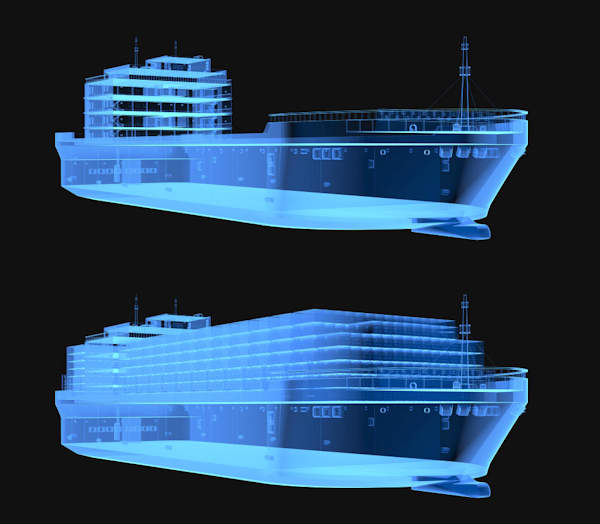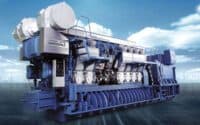Seas of Change: How Robotics and Automation Are Revolutionizing Ship Construction

Shipbuilding, one of the world’s oldest and most intricate crafts, has witnessed remarkable evolution over the millennia. From the primitive wooden rafts of our ancestors to the massive steel giants that traverse our oceans today, shipbuilding techniques and tools have transformed in response to the challenges and demands of the times.
* Please send feedback/suggestions to editor @ shipuniverse.com
With the onset of the industrial revolution, there was a paradigm shift in production processes across industries, and shipbuilding was no exception. The last few decades have particularly been transformative, as robotics and automation started making their way into the shipyards. These technological introductions were not merely about modernization—they symbolized a new era, promising unprecedented precision, efficiency, and safety.
In today’s competitive global market, robotics and automation have become pivotal. They hold the key to ensuring shipyards can meet the increasing demands for speed and accuracy, all while maintaining safety standards and quality. The significance of these technologies is evident, with robots handling complex welding tasks and automated systems overseeing the intricate design and planning stages, underlining the critical role they play in modern shipbuilding.
Historical Perspective
The shipbuilding methods of yesteryears, dominated by manual labor and rudimentary tools, were a blend of skill, experience, and artistry. As the ships grew larger and more complex, there was an evident strain on these traditional methods. With the dawn of the industrial age, machines began to appear in shipyards, promising enhanced production rates and better consistency. However, this shift was not universally welcomed. Many viewed these machines with skepticism, fearing the loss of jobs and the erosion of craftsmanship that had defined shipbuilding for generations.
Despite the initial apprehensions, the benefits of mechanization became hard to ignore. Tasks that previously took days could now be completed in hours, and the quality of construction saw notable improvements. By the mid-20th century, a new era was dawning. As technology continued its relentless march, mechanization began to give way to robotics and true automation. Robotic arms replaced human welders in some tasks, and computer systems took on roles in design and simulation. The shipyard was no longer just a place of hammers and steel; it had become a theater of technological innovation.
This transition from manual methods to machines, and from machines to robotics, was not just a change in tools—it represented a fundamental shift in how ships were conceived, designed, and built. The future was clear: robotics and automation were here to stay, forever altering the landscape of shipbuilding.
Key Robotics and Automation Technologies in Use
The modern shipyard bears little resemblance to its predecessors. Today, it is an epicenter of technological innovation, brimming with advanced machinery and automated systems designed to enhance precision, boost efficiency, and guarantee safety. Let’s delve deeper into the primary robotics and automation technologies shaping the contemporary shipbuilding landscape:
- Robots for Welding, Material Handling, and Precision Tasks:
- Welding Robots: These are specialized robotic systems optimized for consistent, high-quality welding operations. Outfitted with sensors and advanced programming, these robots ensure precision even in intricate joints, leading to increased structural integrity of the ships.
- Material Handling Robots: Speed and efficiency are paramount in shipyards, and material handling robots excel in transporting heavy or bulky materials from one point to another. These robots can operate around the clock, drastically reducing the time taken for ship assembly.
- Precision Task Robots: Beyond welding and material handling, there are robotic systems designed for specific tasks like painting, drilling, or cutting. By utilizing these robots, shipyards can guarantee a high degree of accuracy, consistency, and quality in their output.
- Computer-Aided Design (CAD) and Computer-Aided Manufacturing (CAM):
- CAD in Shipbuilding: CAD software allows naval architects and engineers to digitally conceptualize and design ship structures. These tools provide a three-dimensional perspective, enabling real-time simulations and tests, ensuring optimal designs and early detection of potential issues.
- CAM in Shipbuilding: Once a design is complete, CAM systems come into play. They translate the digital designs from CAD software into actionable instructions for machinery and robots on the shipyard floor. This seamless integration ensures that the ship’s construction aligns perfectly with the envisioned design.
- Autonomous Vehicles and Drones:
- Autonomous Vehicles: Within expansive shipyard areas, autonomous vehicles can efficiently transport materials and components. Guided by sensors and pre-programmed routes, these vehicles optimize logistics within the shipyard, ensuring that resources are available where and when they’re needed.
- Drones for Inspection and Surveying: Drones equipped with high-resolution cameras and sensors are now commonplace in shipyards. They offer a bird’s-eye view of the construction process and can access hard-to-reach areas, ensuring thorough inspections and accurate surveying. This aerial perspective aids in quality assurance and safety checks, making sure that every phase of ship construction meets the highest standards.
The integration of these robotics and automated technologies is not just a testament to the industry’s forward momentum. It’s a clear indication of a future where shipbuilding becomes even more streamlined, efficient, and innovative, all while adhering to the rigorous safety and quality standards the industry is known for.
Benefits of Robotics and Automation in Shipbuilding
The marriage of shipbuilding with robotics and automation isn’t just a superficial integration of modern tools. It represents a fundamental shift in the way ships are constructed, promising vast benefits that ripple across various dimensions of the shipbuilding process. Here are the paramount advantages of this integration:
- Improvements in Precision and Accuracy:
- In a domain where minor discrepancies can lead to significant maritime mishaps, precision is non-negotiable. Robotics, with their programmed perfection, ensure that every weld, cut, and placement is executed with remarkable accuracy. The digital designs from CAD software leave no room for error, ensuring that the end product matches the blueprint flawlessly. This accuracy minimizes the chances of defects, ensuring ships that are more robust and dependable.
- Enhanced Safety in Shipyards:
- Traditional shipbuilding processes exposed workers to a myriad of hazards – from welding flashes to the peril of handling heavy materials. Robotics and automation step in to shoulder these high-risk tasks. By relegating the more dangerous duties to machines, human exposure to potentially life-threatening situations is significantly diminished. This not only ensures the wellbeing of the workforce but also reduces downtime and associated costs due to accidents.
- Acceleration of Shipbuilding Processes and Reduced Production Times:
- Time is of the essence in the commercial world. Automated systems and robots work tirelessly, free from the constraints of fatigue or the need for breaks. This continuous operation accelerates the shipbuilding process. Moreover, the seamless integration of CAD and CAM systems ensures that there’s no lag between design finalization and the commencement of production, culminating in faster turnarounds and more ships launched within shorter timeframes.
- Reduction in Labor Costs and Dependency:
- While there are initial costs involved in procuring and setting up robotics and automated systems, the long-term economic benefits are palpable. Robots, once operational, lead to a drastic reduction in labor costs. They can operate around the clock without the need for overtime pay or benefits. Furthermore, the dependency on skilled labor for intricate tasks is diminished. While this raises concerns about potential job losses, it’s worth noting that the nature of jobs evolves, with more emphasis on robot maintenance, system programming, and oversight, heralding a shift from manual labor to more specialized roles.
Challenges and Limitations
While the integration of robotics and automation in shipbuilding ushers in a plethora of benefits, it is not devoid of challenges. It’s essential to understand these hurdles to optimize the adoption process and mitigate potential pitfalls:
- Initial Investment:
- Integrating robotics and automation demands a significant upfront financial commitment. For many shipyards, especially smaller establishments, this can pose a financial strain. The costs aren’t limited to just procuring the machinery; there are additional expenses related to infrastructure modifications, software licenses, and system setups.
- Skill Requirements and Specialized Training:
- With sophisticated machinery comes the need for specialized skills. Existing shipyard personnel, accustomed to traditional methods, may face a steep learning curve. This necessitates comprehensive training programs, further demanding time and financial resources.
- Potential Job Losses:
- As robots take over tasks previously executed by humans, there’s growing concern about job displacement. While new roles do emerge, like robot maintenance and system programming, the net number of jobs might decrease, leading to social and economic challenges.
- Technical Challenges:
- Advanced machinery and software systems are not immune to technical glitches. Maintenance requirements, software malfunctions, or integration issues can lead to unexpected downtimes, potentially affecting production timelines.
The Future of Robotics and Automation in Shipbuilding
The shipbuilding industry stands on the cusp of even more profound transformations, as emerging technologies continue to shape its horizon:
- The Role of AI and Machine Learning:
- As ship designs become more intricate and the demand for customizations grows, AI and machine learning are poised to play pivotal roles. These technologies can analyze vast datasets, optimizing designs based on specific requirements and predicting potential challenges even before production commences.
- Potential Innovations:
- Fully Automated Shipyards: Imagine shipyards where the entire production line—from design conceptualization to the ship’s launch—is automated. Such levels of automation could drastically reduce production times and ensure unparalleled quality consistency.
- AI-driven Design Processes: With AI’s capability to process and analyze vast amounts of data, future ship designs could be predominantly AI-driven, taking into account factors like fuel efficiency, environmental considerations, and specific user requirements to conceive optimized blueprints.
- Implications for the Global Shipbuilding Industry:
- The industry’s shift towards comprehensive automation will inevitably influence global dynamics. Countries that adapt quickly, investing in technology and workforce re-skilling, might gain competitive advantages. This transformation will also redefine job roles, with a higher emphasis on specialized skills, leading to a more technologically adept workforce.
In summary, while the road to complete automation in shipbuilding presents its set of challenges, the future is undeniably promising. It envisions an industry characterized by efficiency, innovation, and adaptability, primed to meet the maritime challenges of the 21st century and beyond.
Additional Resources
- International Maritime Organization (IMO)
- Description: A specialized agency of the United Nations responsible for regulating shipping. The organization covers technological advancements in the industry among other topics.
- The Royal Institution of Naval Architects (RINA)
- Description: RINA offers a range of resources on naval architecture and the maritime industry, including potential content about robotics and automation in shipbuilding.
- Robotics Business Review
- Description: A website that delves into the application of robotics across various industries, potentially including shipbuilding.
- World Maritime News
- Description: A leading maritime news portal that covers a broad range of topics related to the maritime industry, including technology trends in shipbuilding.

Do you have a Maritime Product or Service that may be of interest to Shipowners? Tell us about it here!
Do you have feedback or insights? Please reach out to editor @ shipuniverse.com



